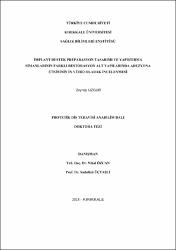| dc.contributor.advisor | Özcan, Nihal | |
| dc.contributor.advisor | Üçtaşlı, Sadullah | |
| dc.contributor.author | Uzgur, Zeynep | |
| dc.date.accessioned | 2021-01-16T18:54:49Z | |
| dc.date.available | 2021-01-16T18:54:49Z | |
| dc.date.issued | 2014 | |
| dc.identifier.uri | | |
| dc.identifier.uri | https://hdl.handle.net/20.500.12587/14265 | |
| dc.description | YÖK Tez ID: 386444 | en_US |
| dc.description.abstract | Sabit protetik restorasyonlar diş kayıplarında, ciddi hasar görmüş dişlerin tedavisinde ve estetik amaçlarla sıkça kullanılan bir restorasyon şeklidir. Dental implantların kullanımı diş hekimlerinin ve hastaların implant tedavisinin biyolojik ve fonksiyonel avantajları konusunda bilinçlenmesiyle hergün daha da yaygınlaşmaktadır. Siman tutuculu protezlerin başarısında yeterli retansiyon ve direnç göstermeleri önemli bir faktördür. Siman tutuculu restorasyonlarda dayanak preparasyonu gerektiğinde preparasyon tasarımı, duvarların yüksekliği ve yüzeylerin pürüzlülüğü retansiyonu etkiler. Bu durumda siman seçimi sabit protetik restorasyonun başarısı açısından önemlidir. Bu çalışmada implant destek preparasyon tasarımı ve yapıştırma simanlarının farklı restorasyon altyapılarında retansiyona etkisinin in vitro olarak incelenmesi ve değerlendirilmesi amaçlanmıştır. Çalışmamızda implant dayanakları ve implant analogları kullanılmıştır. Bu dayanaklar üzerinde farklı preparasyonlar yapılmıştır. Preparasyon yapılan dayanaklar üzerine metal ve zirkonya alt yapı üretimi gerçekleştirilmiştir. Üretilen alt yapılar dayanaklara farklı simanlarla simante edilmiştir. Simantasyon işlemi tamamlanan örnekler çekme testine tabi tutulmuştur. Tüm örneklerde retansiyon açısından metal alt yapılar zirkonya alt yapılardan daha başarılı bulunmuştur. Preparasyon şekli zirkonya alt yapılarda retansiyonu etkilerken, metal alt yapılarda retansiyon açısından anlamlı bir fark bulunamamıştır. Çalışmamızda kullanılan simanlardan kompozit rezin siman tüm örneklerde retansiyon açısından en başarılı siman bulunmuştur. | en_US |
| dc.description.abstract | Fixed partial dentures are commonly used to restore missing tooth, severely damaged teeth and aesthetic. The use of dental implants in everyday practice is rapidly increasing, as patients and dentist become more aware of biological and functional benefits of this treatment, compared to traditional fixed partial dentures of removable prosthetic appliance. The success of cement-retained designs depends largely on adequate retention and resistance. There are many factors affects that can influence amaount of retention sucs as preparation design, axiall wall height and surface roughness when abutment preparation is needed. In this case Cement selection is an important factor for restoration success The aim of this study was to investigate the effect of 4 implant abutment designs by varying the number and position of the axial walls and 3 different cements on the retention of cement-retained crowns for two differrent frameworks Four prefabricated abutments were attached to an implant analog. The first abutment was left intact without modification. Axial walls were partially removed from the remaining abutments to produce abutments with 2 adjacent walls, 2 opposing walls, and 1 wall. Metal and zirconia famework were made for each group. The screw access channel for abutments was completely filled with composite resin. Crowns were cemented with resin modified glass ionomer cement, self-etch resin cement and self-adhesive resin cement. Tensile force was applied to separate the fameworks. Peak load to dislodgment was recorded. The abutment with 2 opposing axial walls had significantly higher retention than that of all other groups for zirconia famework. Self-etch resin cement showed higher adhesion than other cements for zirconia fameworks. Such a classification is impossible for metal fameworks. But resin modified glass ionomer cement had significantly lower retention than that of all other groups for both zirconia and metal fameworks. Furthermore metal fameworks showed higher success rate than zirconia fameworks. The retention of cemented crowns on implant abutments is influenced by the number and position of axial walls, different famework materials and different cements. | en_US |
| dc.language.iso | tur | en_US |
| dc.publisher | Kırıkkale Üniversitesi | en_US |
| dc.rights | info:eu-repo/semantics/openAccess | en_US |
| dc.subject | Diş Hekimliği | en_US |
| dc.subject | Dentistry | en_US |
| dc.title | İmplant destek preparasyon tasarımı ve yapıştırma simanlarının farklı restorasyon alt yapılarında adezyona etkisinin in vitro olarak incelenmesi | en_US |
| dc.title.alternative | Evaluation of implant support preparation design and luting cements on different restoration substructures due to adhesion | en_US |
| dc.type | doctoralThesis | en_US |
| dc.contributor.department | KKÜ, Sağlık Bilimleri Enstitüsü, Protetik Diş Tedavisi Anabilim Dalı | en_US |
| dc.identifier.startpage | 1 | en_US |
| dc.identifier.endpage | 112 | en_US |
| dc.relation.publicationcategory | Tez | en_US |
















